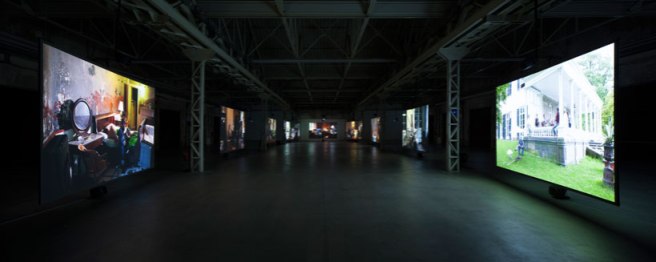Although I am aware that my research encompasses perhaps too many avenues to simplify into a single project, I have become preoccupied with the notion of a mass-psychology. Two particular exhibits held at Ffotogallery in Cardiff as part of the Artist Mundi contemporary art exhibition and prize caught my attention. ‘The Visitors’ by Icelandic artist Ragnar Kjartansson and ‘The Disobedients’ by Croatian artist Sanja Iveković portrayed themes that echoed this idea of a mass-psychology. ‘The Visitors’ is a multimedia piece that combines a stimulating video exhibit with haunting music composed by the artist / performer Ragnar and fellow musicians. On entering the dim lit room I immediately became aware of an expansive ensemble of sound, the sound permeated from nine distinct screens, each screen came to be a platform for each individual voice. This piece was captivating throughout but most pertinent for me was the arrangement of the exhibit to deliver ‘individual minds at work, baring of extreme collective emotion’ (Kjartansson). I think what interested me most about this work was how it visually depicted the thoughts I was having regarding a social system based on actor-network-theory, particularly to a cohesive social construct.
‘The Visitors’ was produced in a country house near New York where each individual was located in different rooms and although the group were connected auditorially they each occupied a sole purpose and I find this to reflect the core element of a culture. Similarly ‘The Disobedients’ by Sanja highlighted the individual stories throughout history that combine to alter society. However unlike Ragnar’s piece which embodied the spirit of social interaction by means of music, Sanja felt that history all too often forgets those single characters: ‘Traditional monuments either extol or absolve the deeds of history and often end up discounting individual stories in order to create an official whole’ (Ivekovic, 2014). Sanja’s Artist Mundi space exhibited a number of projects that cohesively grappled with the notion of forgotten stories. ‘GEN XX’ incorporates photographs of female models found in magazine advertisements and introduces a new juxtaposing context by applying text that articulates the stories of young females who fought against the Nazi Regime. ‘The Disobedients’ presents a number of stories from key cultural figures and formulates their personal plight. I found this piece to be particularly poignant as I had come across a number of the individuals in my own work and their influences on society but had not understood their stories in such detail until now.
Whether approached as an anthropological study in order to apprehend human relationships or as an actor-network to understand the transference of knowledge via social constructs, the sheer depth and complexity that reside in culture theory remains fascinating to me. At this moment in time I am evaluating its importance in my overarching project and despite the resolve I know that I will explore this subject matter again in the future.
Both Barthes and Baudrillard were strikingly uninterested in any discussion of the role of the designer, preferring instead to regard the disposition of things as the physical manifestation of a mass psychology.
The Language of Things Deyan Sudjic
'The Visitors ' Ragnar Kjartansson
IVEKOVIḈ, S. (2014) ‘The Disobedients’ Exhibition Placard. Ffotogallery, Cardiff, Wales.
KJARTANSSON, R. (2014) ‘The Visitors’ Exhibition Placard. Ffotogallery, Cardiff, Wales.
SUDJIC, D. (2008) The Language of Things. London: Penguin Group.

No comments.